Ww2 Original German Press Photograph 18x 12 CM General Von Kleist Staff Car
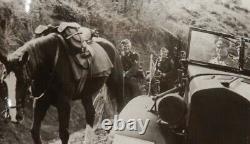
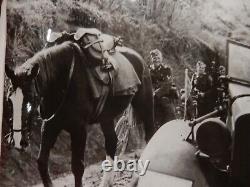
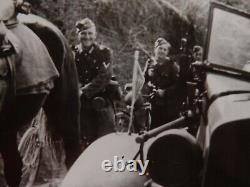


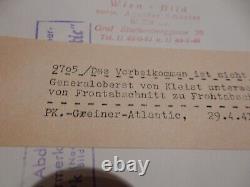
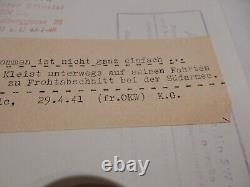
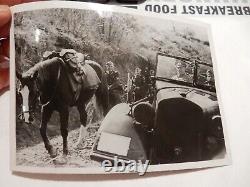

ORIGINAL ITEM NOT A MODERN COPY OR REPRODUCTION storage 18.1. Kleist was promoted to Generaloberst on 19 July 1940 and received the Knight's Cross of the Iron Cross.
In April 1941 Panzer Group Kleist was renamed to 1st Panzer Group and spearheaded the invasion of Yugoslavia. Deployed against central Yugoslavia (Serbia), units of the 1st Panzer Group were the first to enter Belgrade.
Invasion of the Soviet Union. In June 1941 with the launching of Operation Barbarossa, Kleist led the 1st Panzer Group as part of Army Group South - tasked with the capture of Moldavia and Ukraine - and saw success in the initial phase of the invasion, advancing deep into Ukraine.
The 1st Panzer Group broke through the Stalin Line, then defeated the five mechanized corps of the Soviet 5th Army and 6th Army in the Battle of Brody (23 to 30 June 1941). In July 1941 during the Battle of Uman, the 1st Panzer Group broke through the Soviet Southern Front's lines, leading to the encirclement and annihilation of the Soviet 6th and 12th armies to the southeast of Uman city (in present-day Cherkasy Oblast). During the First Battle of Kiev of August-September 1941, 1st Panzer Group's northward turn from central Ukraine in conjunction with 2nd Panzer Group's southward advance from Smolensk led to the encirclement and destruction of the entire Soviet Southwestern Front east of Kiev, inflicting over 600,000 losses on the Red Army.
However, the campaign had been costly, by then the German forces had just half the tanks they had had three months earlier. After operations at Kiev concluded, Kleist's 1st Panzer Army advanced east to capture the important industrial Donbass region. On 26 September 1941 the Battle of the Sea of Azov began as the Southern Front launched an attack on the northern shores of the Sea of Azov against the German 11th Army advancing into the Crimea. On 1 October the 1st Panzer Army swept south and encircled the two attacking Soviet 9th and 18th armies at Melitopol (Zaporizhia Oblast), by 11 October both Soviet armies had been destroyed and the 1st Panzer Army had taken the Donbass. [8] The 1st Panzer Army then attacked east along the shore of the Sea of Azov toward Rostov near the mouth of the Don river, the last barrier before the Caucasus.
On 17 November 1941 the German forces forced their way across the Mius River and launched an offensive against the Southern Front at Rostov. On 19 November 1941 the 1st Panzer Army reached Rostov and the following day, they seized bridges over the river Don. Three days after reaching Rostov the 1st Panzer Army had captured the city. [9] However, on 27 November the Southern Front, as part of the Rostov Strategic Offensive Operation, counter-attacked the 1st Panzer Army's over-extended spearhead from the north, forcing them to pull out of Rostov. By 2 December 1941, the Soviet forces had retaken Rostov and forced the 1st Panzer Army to withdraw back to the Mius River, near Taganrog.[9] This marked the first major German withdrawal of the war. On February 18, 1942, Kleist was awarded the Oak Leaves to his Knight's Cross.
Main article: Second Battle of Kharkov. Kleist greeting an Italian officer near Dnepropetrovsk, 1941. During the Second Battle of Kharkov on 17 May 1942 as part of Operation Fredericus, Kleist's 1st Panzer Army attacked the Barvenkovo bridgehead from the south, advancing up to ten kilometres in the first day of the attack. On 19 May, the German 6th Army led by General Friedrich Paulus launched an offensive north of the bridgehead, encircling the Soviet 6th Army and 57th Army. [10] After six days of encirclement, both armies were destroyed. By 28 May Kleist and Paulus' armies had captured 240,000 prisoners and destroyed or captured over 1250 Soviet tanks and 2000 artillery pieces. Main articles: Case Blue and Operation Little Saturn. The summer of 1942 saw Army Group South subdivided into Army Group A and B. Army Group A, which included Kleist's 1st Panzer Army, had the task of leading the Axis thrust into the Caucasus in the execution of Case Blue, the German offensive which aimed to capture the important oilfields of Grozny and Baku. [11] The 1st Panzer Army was to spearhead the attack. Army Group A advanced deep into Southern Russia, capturing Rostov, Maykop, Krasnodar and the Kuban region. However, heavy Soviet resistance and the long distances from Axis sources of supply eventually reduced the Axis offensive to local advances only and prevented the Army Group A from capturing their ultimate objectives.On 22 November 1942, Kleist replaced Field Marshal Wilhelm List as commander of Army Group A near the end of Case Blue. Hitler ordered him to hold position and to resume the offensive should the Axis forces take Stalingrad.
This possibility ended after the Soviets launched counter-offensives Operation Uranus (November 1942), which encircled the German 6th Army in Stalingrad, and Operation Little Saturn (December 1942 to February 1943). Little Saturn aimed to cut off Army Group A in the Caucasus, however, the limited scope of the Soviet offensive gave Kleist enough time to withdraw his Army Group A in the direction of the Kuban, abandoning the Caucasus. Battle of the Dnieper and dismissal. Main articles: Battle of the Dnieper and Nikopol-Krivoi Rog Offensive.
On 1 February 1943 Kleist was promoted to Field Marshal. In July 1943 the Red Army launched a massive offensive along the Dnieper river. By December 1943 the Soviets had liberated the west bank of the Dnieper, and Kleist's Army Group A was forced to retreat to southwest Ukraine. In December 1943 the Soviets launched the Dnieper-Carpathian Offensive against Erich von Manstein's re-constituted Army Group South, intending to capture all of the Ukrainian and Moldovian territories occupied by the Axis forces.
As part of the initial phase of the offensive, the Soviet 3rd Ukrainian Front to the south launched the Nikopol-Krivoi Rog Offensive against Kleist's Army Group A. Proceeding slowly at first, the front eventually destroyed the salient projecting around Kryvyi Rih and Nikopol, costing the Germans the important mining operations there as well as nearly encircling the reformed German 6th Army. [14] By the end of March 1944 the Soviets had recovered most of right-bank Ukraine and the Germans were defeated with 20 divisions either destroyed, disbanded or requiring major rebuilding, while another 60 divisions were reduced to 50% of their establishment strength. [15] Kleist had disagreed with Hitler over the withdrawal of Army Group A during the offensive. He had demanded permission to pull back his forces to more defensible positions, however, Hitler ordered his armies to stand where they were. [16] Hitler blamed his generals for the overall strategic success of Soviet armies and on 30 March 1944, Kleist was dismissed and replaced by Ferdinand Schörner. After the 20 July plot to assassinate Hitler failed (1944), the Gestapo implicated and arrested Kleist due to the involvement of his cousin Ewald von Kleist-Schmenzin in the Oster conspiracy.Kleist avoided trial and was later released. Kleist was arrested in late April 1945 in Bavaria by United States' troops, and handed over to the British Army. In September 1946 he was extradited to Yugoslavia, where after a trial he was sentenced to fifteen years in prison for war crimes.
In 1948 he was extradited to the Soviet Union, where he was charged with war crimes. [3] After a trial he was sentenced to 25 years in prison. On 13 November 1954 Kleist died of heart failure in Vladimir Central Prison. He was the most senior ranking soldier among the German prisoners of war in the Soviet Union to die in Russian captivity.

